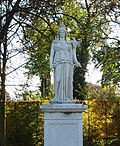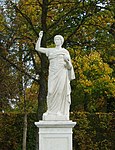Eduard Stützel
Carl Heinrich Eduard Stützel (born June 11, 1806 in Berlin ; † after 1862; also Stietzel ) was a German woodcarver and sculptor who worked in Berlin and especially in Potsdam .
Career
Stützel studied at the Royal Prussian Academy of Arts in Berlin. Between 1826 and 1840 he showed woodwork at the academy exhibitions, including a linden wood arabesque from the Italian Middle Ages based on a design by Karl Friedrich Schinkel in 1832 , and a statuette of the Prussian King Friedrich Wilhelm III in 1834 . made of boxwood after Ludwig Wilhelm Wichmann and a boxwood statuette by the poet Johann Wolfgang von Goethe . Busts and medallions in plaster of paris and marble were created according to his own designs. In 1829 he received a public commendation for his achievements.
Friedrich Wilhelm IV. Summoned Eduard Stützel to Potsdam in 1840. After taking office, the Prussian king devoted himself not only to the construction of new buildings and their sculptural decoration, but also to the restoration and restoration of old works of art from the Frederician era in Sanssouci Park . Some of the original figures in the park had previously been given to the newly founded Berlin museums and since the attempt to retrieve individual works failed due to the resistance of the general director Ignaz von Olfers , who had been active since 1839 , they were replaced by copies in Potsdam. Eduard Stützel was entrusted with this task, along with other artists, who created replicas of ancient sculptures, including standing figures for the semicircle at the New Palace , busts in the circular figures in the park and based on designs by fellow sculptors, allegorical figures on the new building of the Orangery Palace . In Potsdam he became a member of the Masonic Lodge Teutonia for Wisdom .
Stützel had been married to Hermine Charlotte Helene Krutisch since 1836. Her children included the sculptor Hermann Eduard Otto Stützel (born January 13, 1837 in Potsdam; † March 15, 1862 ibid).
Works (selection)
- 1832 Linden wood arabesque from the Italian Middle Ages, based on a design by Karl Friedrich Schinkel
- 1834 Statuette of the Prussian King Friedrich Wilhelm III. made of boxwood, after Ludwig Wilhelm Wichmann
- 1834 boxwood statuette of the poet Johann Wolfgang von Goethe
- 1841 "Mohrin", copy (made of black limestone and white marble) of a bust from the 17th century. Mohrenrondell in Sanssouci Park, today in Schloss Caputh (replaced by a copy in the roundabout).
- around 1843 “Bacchant with animal skin and goat head”, copy after Jean Cherin around 1773, Neues Palais, Sanssouci Park
- 1844 “Thalia with castanets, scroll and measuring instruments” and “ Melpomene with book, crown and dagger”. Origin Copies in the Musenrondell, Sanssouci Park (replaced by copies)
- 1850–1857 “Flying Victoria”, 1850; "Resting Satyr", 1853; "Apoll Lykeios with Kithara", 1854; "Fortuna", 1855; "Archer", 1856; “Urania with a Celestial Ball”, 1857; “Antony as Mercury”, 1858; Copies based on ancient figures, Neues Palais (semicircle, park side), Sanssouci Park
- 1852 "Apollo with lyre", copy of a Roman antiquity, new chambers (central projection), Sanssouci Park
- 1855 “ Amalie zu Solms-Braunfels ”, copy of a bust by François Dieussart, probably made in 1647 (original not preserved). Copy after Stützel by Konscha Schostak in the Oranierrondell, eastern pleasure garden, Sanssouci Park
- 1858 "Capitoline Antinous" in front of the New Palace, Potsdam (copy probably by Eduard Stützel)
- 1861 "Flora", based on a design by Ferdinand Hieronymus Schindler , Orangery Palace (top terrace)
- 1862 “Naiade rides a lion with a fish tail”, based on a model by Julius Franz (1858). Sicilian garden in Sanssouci Park
- from 1863 to 1868 allegories of the months and seasons, orangery castle
- 1863 "May", based on a model by Hermann Wittig (1862), on the west wing
- 1864 "June", based on a model by Hermann Schievelbein (1863), on the west wing
- 1865 “April”, based on a model by Hermann Schievelbein (1863), on the west wing
- 1865 "November", based on a model by Julius Franz (1864), on the east wing
- 1866 “The August”, based on a model by Julius Franz (1864), on the east wing
- 1866 “The March”, based on a model by Hermann Schievelbein (1864), on the west wing
- 1867 “Winter”, based on a model by Julius Franz (1865), on the east wing
- 1868 "September" based on a model by Julius Franz (1865), on the east wing
- 1868 "Spring", based on a model by Julius Franz (1866), on the west wing
literature
- Stützel, Eduard . In: Karl Klunzinger, Adolf Friedrich Seubert, Friedrich Müller (eds.): The artists of all times and peoples; or the lives and works of the most famous builders, sculptors, painters, engravers, form cutters, lithographers ... Volume 3 : M-Z . Ebner & Seubert, Stuttgart 1864, p. 628 ( Textarchiv - Internet Archive ).
- Stützel, Eduard . In: Adolf Friedrich Seubert (Ed.): The artists of all times and peoples; or the lives and works of the most famous builders, sculptors, painters, engravers, form cutters, lithographers ... Volume 4 : Supplements since 1857 . Ebner & Seubert, Stuttgart 1870, p. 416 ( Textarchiv - Internet Archive ).
- Stützel, Eduard . In: Hans Vollmer (Hrsg.): General lexicon of fine artists from antiquity to the present . Founded by Ulrich Thieme and Felix Becker . tape 32 : Stephens – Theodotos . EA Seemann, Leipzig 1938, p. 243 .
Web links
Individual evidence
- ↑ Baptismal register Sophienkirche, No. 347/1806.
- ^ Marriage register Garrison municipality Potsdam. 1836 fol. 109.
| personal data | |
|---|---|
| SURNAME | Stützel, Eduard |
| ALTERNATIVE NAMES | Stützel, Carl Heinrich Eduard; Stietzel, Carl Heinrich Eduard |
| BRIEF DESCRIPTION | German wood carver and sculptor |
| DATE OF BIRTH | June 11, 1806 |
| PLACE OF BIRTH | Berlin |
| DATE OF DEATH | after 1862 |




